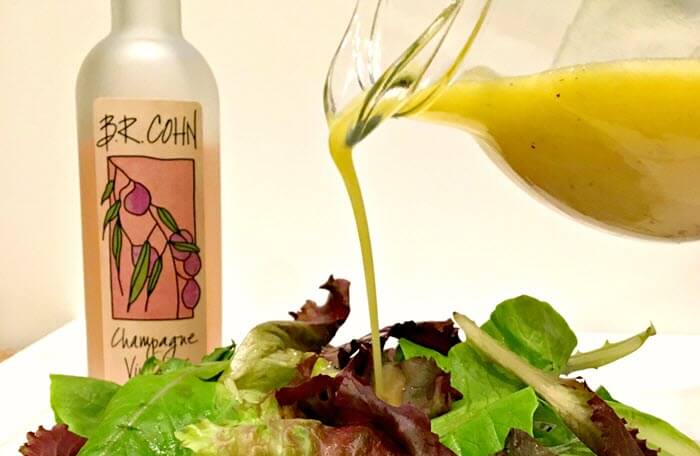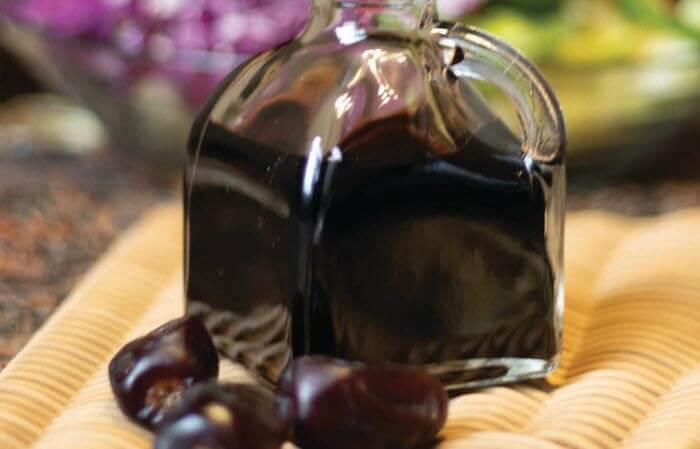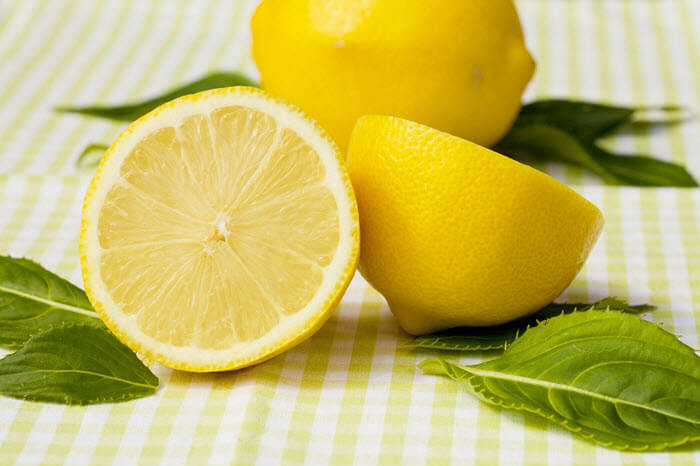What’s the nutty, oozing, slightly acidic, and sharp flavor sauce that goes with the beloved fish and chips?
Well, it’s not ketchup or tartar, or even soy sauce.
Without further ado, yes you’ve guessed it right, it’s malt vinegar!
But, what if you run out of malt vinegar or can’t find it in your local store? Or do you want to change up things and are looking for a malt vinegar substitute for fish and chips?
Thankfully, there are many, and we have put together 13 malt vinegar substitutes. Keep reading to learn about the details.
Table Of Contents
The Unique Malt Vinegar
Malt vinegar is popular in Canada, Australia, and Ireland but is a versatile condiment in the world of British fried foods, especially with fish and chips. And it also tastes fantastic in a simple salad dressing called a gastrique when combined with fresh herbs, tomato, and olive oil.
Malt vinegar is prepared from malted barley grains also known as ale. When the ale is ready, it undergoes fermentation to become vinegar. The result has a gentler, sweeter, and more varied flavor spectrum.
It has a tangy, crisp flavor which can help bring out the flavors of other meals when combined.
What Can You Substitute for Malt Vinegar
1. Sherry Vinegar
Sherry vinegar is essentially the Spanish equivalent of malt vinegar. They are so comparable!
The flavor of this one can be increased without the addition of any other ingredients! Sherry vinegar has a distinctive sweet scent that is complemented by a nutty, rich flavor.
Because it has a stronger acidity than malt, be careful not to use it excessively as it may overpower other scents.
How to Substitute
Depending on your preference, begin with a 1:2 ratio and work your way up from there.
2. White Vinegar
White vinegar is the result of grain alcohol exposed to oxygen. From the bacterium that develops there, acetic acid is produced resulting in vinegar. Maybe we don’t need to know all the specifics?
We only need to be aware that white vinegar with clear hue results from the fermentation process. White vinegar is a less expensive, gluten-free substitute for malt vinegar.
How to Substitute
If you’re going to sprinkle it on top of meals, start with a little and add more as you go. It is wise to taste it since the clear style is sour and a bit acidic.
3. Champagne Vinegar
When you hear the name champagne, you may think of some exotic and fine celebration. Well, as the name itself says, champagne vinegar is made from the same type of grapes used in making champagne.
It is matured in oak barrels for around two years, giving it a mild, fruity flavor with notes of wood.
You may think why would we include it in this list as a suitable replacement for malt vinegar?
Due to its lightness and mild acidity, similar to malt vinegar, it’s a fantastic malt vinegar substitute for fries or sprinkling.
4. Balsamic Vinegar
Balsamic vinegar is an excellent option because of its sweeter side if you’re searching for vinegar to drizzle over your fried food, similar to malt vinegar.
Only grapes can be used to make authentic balsamic vinegar, which is then matured for at least 12 years and up to 25 years. The cost of this alternative to malt vinegar will probably fluctuate widely.
How to Substitute
The less expensive balsamic vinegar options will taste more tangy and acidic with less sweet undertones.
So, use a higher quality balsamic if the classic sweet flavor is what you’re after.
5. Red Wine Vinegar
To begin, red wine vinegar has a darker shade and a comparable sweet and tangy flavor, so you can replace it without changing the aesthetic of your dish.
However, red wine vinegar lacks the earthy and malty undertones that you presumably find in malt vinegar. In light of this, we advise using red wine vinegar in dishes that won’t rely primarily on malt vinegar. Use it in dishes when other ingredients are the star.
How to Substitute
To give your dish the proper acidity, we only advise using half as much red wine vinegar in a recipe that asks for malt vinegar.
6. Apple Cider Vinegar
You may have seen apple cider vinegar in almost all health magazines out there. Many people drink it straight up or blend it with honey and water as a morning shot.
Apple cider vinegar is your next best option if you prefer fruit-based vinegar to the complicated, grain-based one because it also has a fresher flavor.
Unlike white vinegar, which would overshadow the entire dish, apple cider vinegar is highly acidic and adds a sharp flavor.
This alternative contains acidity and sweetness similar to malt vinegar, but with a little lighter flavor.
Further reading: Apple Cider Vs. Apple Cider Vinegar
7. Soy Sauce
Because soy sauce’s sourness can easily compete with malt vinegar on a one-to-one basis, it makes a great alternative.
They both share the qualities of being acidic, providing that pop of taste we keep describing. However, one distinction should be made. Soy sauce has a higher salt content.
How to Substitute
You should modify your salt requirement in any dish when using soy sauce. Additionally, while sprinkling food, begin with a small amount and increase as necessary.
8. Worcestershire
This exclusive sauce contains molasses, cloves, sugar, soy, anchovies, vinegar, and garlic, along with a long list of ingredients.
Worcestershire is a sound alternative for malt vinegar due to its strong and complex flavor. When you first taste it, it has both the “wow” impact and the savory quality known as umami.
It is somewhat sweet, slightly sour, and a little salty.
How to Substitute
Start with half of the required amount of malt vinegar, and adjust the amount higher to taste.
9. Rice Vinegar
Rice vinegar comes in many varieties, either pure or with flavorings like orange peel and ginger, and has no additional malt. You must consider the various flavors because they could affect how your dish will taste.
How to Substitute
Rice vinegar is fermented for a longer period, giving it a richer, more potent flavor. In light of all this, we advise incorporating only half of the rice vinegar called for in the recipe at first.
Use this alternative in savory dishes like stir-fries that call for malt vinegar, dressings, marinades, and pickling combinations.
10. Date Vinegar
Date vinegar is a good option if you want something a little sweeter. As its name implies, this vinegar has a fruit foundation since it is manufactured from fermented dates.
Date vinegar is a great alternative to malt vinegar because their flavor profiles are similar. For enhanced flavor, date vinegar also contains herbs and spices in addition to dates.
As a result, you can anticipate an eccentric sweetness to it, which will balance out the tart acidity of normal vinegar.
How to Substitute
Any recipe that calls for date vinegar can be used in an equal to a one-to-one ratio.
Fun fact, among all vinegar varieties, date vinegar is the earliest type [1] of vinegar ever recorded!
11. Cane Vinegar
Cane vinegar, named as it is manufactured from molasses from sugar cane, is a type of vinegar that is frequently used in Filipino cooking.
Even though cane vinegar is a sugar cane byproduct, it is not sweet. There is no denying its acidity and robust flavor, yet it is nonetheless mellower than malt vinegar and more akin to sherry vinegar in comparison. Due to this, it works well with fish and chips.
How to Substitute
You can substitute cane vinegar for malt vinegar in a one-to-one ratio.
12. Lemon
Lemon goes well with many different cuisines that its simplicity—which is its most striking quality—might be overlooked.
Even just a squeeze of lemon can have wonderful effects on our taste senses. When lemon is present, bland or uninteresting food is no longer an option. One thing is certain: Lemon is not vinegar.
However, the two still have a lot in common. Lemon and malt vinegar both include acidity, that sharp blast of sourness that helps us wake up.
Once you get over the initial jolt, you can pick out the other flavors since they all have a mellow finish.
13. White Wine Vinegar
If you’re not into complex flavors, white wine vinegar can be used in place of malt vinegar. More acidic and slightly fruitier than red wine vinegar, white wine vinegar is lighter and brisker.
Mixing dark soy sauce will give you the fruitiness and umami qualities you’ll enjoy if you think white wine vinegar tastes too basic. You’ll also get a dark color that resembles malt vinegar.
Further reading: 8 Best White Wine Vinegar for Salad Dressing/Cooking
FAQs About Malt Vinegar
Is Malt Vinegar The Same As Cider Vinegar?
The primary distinction between cider vinegar and malt vinegar is their respective sources.
Apple cider vinegar is derived from apple cider, an alcoholic beverage manufactured from apple juice, while malt vinegar is derived from malted barley, a grain used to make ale that is turned into vinegar.
Is Malt Vinegar The Same As Red Wine Vinegar?
Malt vinegar has the advantage of being made straight from ale, while red wine vinegar is made from wine, and then fermented until it becomes vinegar.
Red wine vinegar gives a softer, sweeter, and more nuanced flavor, while malt vinegar gives an earthy, malty, and intricate flavor.
Does Malt Vinegar Need To Be Refrigerated?
The good news is that malt vinegar has an “almost endless” shelf life although it is a fermented product by nature.
It does not require refrigeration due to its acid composition and self-preserving quality [2].
To Wrap It Up
Since there are so many varieties of vinegar to pick from, replacing malt vinegar is not that tough.
If you don’t like sour flavor, sweeter substitutes offer a mild tanginess to please your palate. Any acidic and sweet component can be combined. It will only improve the flavors to include other ingredients.
We hope these 13 substitutes will help you choose the next best vinegar to go with those golden crisp fish and chips!














